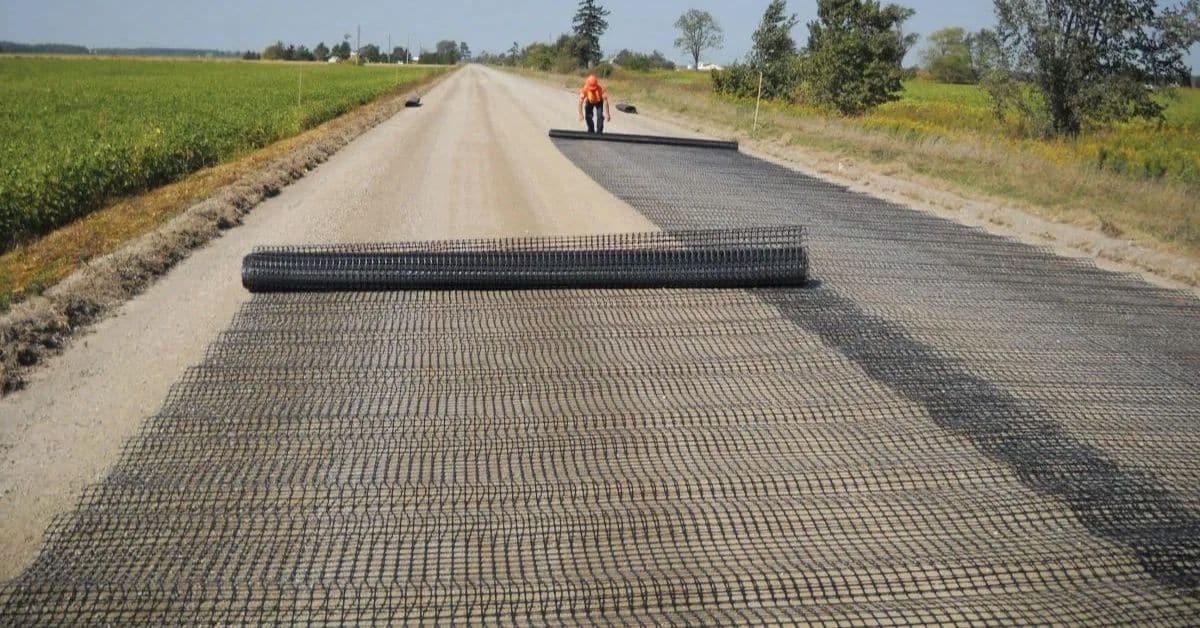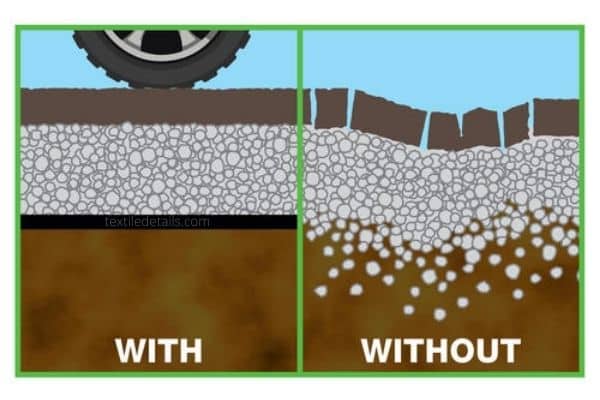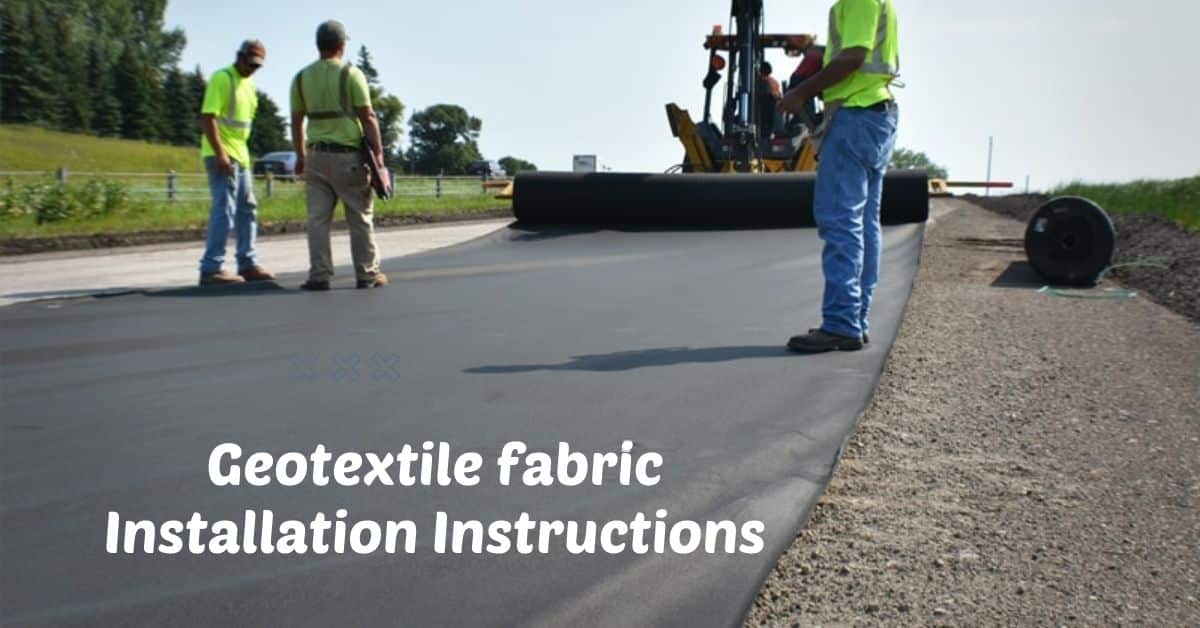The term “Geotextiles” is derived from the words “Geo” and “Textiles.” Geotextiles are permeable fabrics utilized in conjunction with the soil’s abilities to protect, separate, filter, strengthen, and drain. In this subcontinent, geotextiles were first introduced in China and Kerala.
Geotextiles are technical fabrics that will dominate the textile market in the future. There are two different kinds of Geotextile fabric produced in the textile industry. One is Woven geotextile fabric, and the other is Non-woven Geotextile fabric. In this article, we will discuss Woven geotextile fabric.
Table of Contents
Woven Geotextile Fabric:
Woven geotextile is a special kind of geotextile that is produced by the weaving process. Woven geotextile fabric is a cost-effective way to separate granular fill materials while providing substructure support. It has a high load capacity.
As a result of this process, it is making them suitable for applications such as road building. Woven geotextiles are resistant to corrosion and may be used for lengthy periods.
What is Woven Geotextile fabric made of?
The woven geotextiles fabric is usually produced by weaving and synthetic polymers. Polyesters, polypropylenes, polyamides, and polyethylene polymer are mainly used to make this fabric.
Individual threads, such as polymers, fibrillated yarns, slitting layers, and other materials, are woven, the homogeneous piece on a loom. This feature makes geo fabric useful for various applications, such as road construction, and maintenance. The materials of the textiles impact how well they can be used. Therefore, it’s crucial to know what makes them tick.
Woven Geotextile Fabric Specifications
Woven geotextile fabrics are mainly produced by weaving. In the textile platform, various woven geotextile fabrics are produced. Here are the types of woven Geotextile fabric in details:
| Types of geotextile fabric | Specifications | Applications Area |
i. Geotextile Geolon PP | A form of Geotextile fabric is Geolon PP is a special of woven fabric. Geotextile Geolon PP fabric is manufactured from 100% polypropylene polymer. This type of geo-fabric has good properties for chemical resistance and material separation. | Utilized to strengthen retaining walls, linear buildings, landfills, and sewer lines, among other things. |
ii. Geotextile Geolon PET | Geotextile Geolon PET is another type of Woven geotextile fabric that is made of 100% Poly Ethylene Terephthalate. This type of geo-fabric has a low strain in increased pressure and a wide variety of compressive strength options. | Used to reinforce embankments, retaining buildings, linear constructions, steep slopes, landfills, waste deposits, etc. |
iii. Poly felt Rock PEC | Poly felt Rock PEC is a kind of woven geotextile fabric that consisting of high-strength polyester fibers. This fabric is made with polypropylene polymer. This fabric has excellent specific strength as a result of this. | Used in highway and civil engineering to strengthen earth construction. |
iv. Geomatex TST | Geomatex TST is a kind of woven geo-fabric produced with modern technology. This geo-fabric is made from 100% polypropylene polymer. Geomatex TST fabric has separation of materials and chemical resistance properties. | Used to build retaining walls, linear buildings, garbage dumps, and drainage systems, among other things. |
Woven Geotextile Fabric Characteristics
- Woven Geotextile fabric is designed for soil reinforcement and retaining structures.
- Has good material separation and chemical resistance properties.
- Woven Geotextile fabric allows for the use of lower-quality fill-in embankments.
- Have a low strain in high tension and a variety of tensile strengths to choose from.
- Geo-fabric combines filtration characteristics and high permeability of water.
What is woven geotextile fabric used for?
Because of Woven Geotextile fabric’s functionality, geotextile fabric is used to make various applications. Geo-Fabric is primarily used in the road and automobile industry. Separation, drainage, filtration, and reinforcement are all made of Geotextile fabric. Moreover, it is also used to make retaining walls, linear buildings, garbage dumps, and drainage systems, etc.

Woven Geotextile fabric Application
Geotextile fabric is a synthetic material that has many potential applications. Geotextile fabrics are made of woven polypropylene and have very low permeability rates, meaning they will not let water pass through them.
It can be used in landscaping to control erosion or reduce runoff from construction sites, as well as being used to create vegetative barriers for various purposes. It’s also popularly applied in the construction industry for ground stabilization, noise reduction on highways and railways, Renewable Energy Products, and other uses. Geotextile fabrics also have the ability to be used in civil engineering applications such as retaining walls and slope stabilization.
Geotextiles can also aid in water management, by being applied on a dam or spillway for example. geotextiles fabric has been found useful for many other purposes too. It is often utilized to protect agricultural land, control water flows in streams and rivers, or to protect archaeological sites. It has the ability to be used as a filter for the containment of landfill leachate.
Geotextile fabrics are very durable, making them an economical option over other materials that may require replacement after heavy usage.
Woven vs nonwoven geotextile fabric
Unlike woven geotextile fabrics, non-woven geotextile fabrics are made from random fibers arranged into sheets. Compared to woven geotextile fabric’s long-lasting characteristics, non-woven fabrics don’t hold much weight. However, they are cheaper and easier to install. Additionally, they come in a variety of colors and patterns to match any style of decoration. Moreover, they resist mildew, rot and mold easily. That’s why many people prefer installing non-woven fabrics over other options such as concrete pavers.
When it comes to selecting non-woven Rotex fabric providers, look out for those who manufacture durable materials. These firms usually focus on producing high-strength fiberglass-based nonwovens. Apart from durability, customers like to choose non-woven geomaterials at having low cost. If you want cheap solutions, then non-woven geosynthetics might be just right for you.
Nonwoven geostrategies include:
a) Waterproof Membranes: A special layer of polyethylene film placed between paving stones and ground surface helps prevent moisture penetration. This membrane acts as a barrier against rainwater entry and prevents damage caused by insects and rodents.
b) Drainage Holes: Having drainage holes in your garden ensures that the area remains dry even after heavy rains. By using a porous substrate, you can avoid building foundations sinking below the level of surrounding land while preventing excessive runoff.
c) Anti-Slip Pads: To keep your driveway safe against slipping accidents, consider buying anti-slip pads. These mats help maintain traction and reduce injuries resulting from slips and falls.
d) Fire Retardants: To prevent fires from spreading rapidly in case of emergency situations, use fire-resistant fabrics during landscaping projects. Such fabrics are designed to withstand temperatures above 500 degrees Fahrenheit without melting or burning.
e) UV Resistant Materials: Protect your plants and flowers from harmful rays by choosing UV protective products. They help stop fading of plant leaves by absorbing ultraviolet light. Furthermore, these products also ensure the long life span of your gardening equipment.
Benefits of using Geotextile Fabric:
1) The use of geotextiles fabric makes jobs simpler for the construction industry. Because it does not need any special equipment to install these products. You don’t even need any tools! Just grab some rope and pull up one end, then tie down the other end.
2) Geotextile Fabrics provide better protection against soil erosion due to their anti-erosion property. Soil erosion occurs when there is excessive rainfall which causes the loose topsoils to wash away. However, if we apply geotextile fabric at the base of the hill, rainwater cannot penetrate deep into the soil. As a result, the soil stays intact and does not get washed away easily.

3) If you want to save space, then geotextile fabrics would be perfect for you since they occupy less area than concrete structures. Concrete requires more space compared to geotextiles fabric. Therefore, if you plan to place them near each other, you should go for geotextiles fabric instead of concrete.
4) Geotextiles fabric offers great durability. These types of fabrics last longer than conventional building materials like bricks and cement. In most cases, they can withstand harsh weather conditions without breaking down. And, unlike ordinary asphalt roads, geotextiles fabric doesn’t crack during winter months because of its extreme cold tolerance.
5) When choosing between plastic and metal fences, choose a fence with steel wire mesh. Metal fencing provides good security while giving privacy to those inside the garden. Steel wires tend to rust quickly so it needs regular maintenance. On the contrary, plastic fencing is easy to clean but lacks strength and looks unkempt over time. Thus, you should opt for wooden fences whenever possible. Wooden fences look elegant and give a traditional feel to the outdoor spaces where they’re installed.
6) Another advantage of using geotextiles fabric is that they help prevent weed growth. Weeds grow abundantly around areas where the soil is not properly protected. This means that weeds usually sprout when exposed to sunlight. By applying a layer of geotextile fabric under the grass lawn, weeds will stay out of sight.
7) Finally, geotextiles fabrics offer added value to your home/landscape project. Depending upon what type of product you purchase, you could add extra features to your landscape design. For instance, you can buy geotextiles that contain drainage holes to allow excess water to seep through rather than flowing freely across your yard. Or, you can opt for a waterproofing membrane to stop leakage altogether. Similarly, you can also select geotextile fabrics having fire-retardant properties for safety concerns.
8) While looking for suitable geotextile fabric manufacturers, make sure you check whether they produce high-quality products only or they also sell inferior ones. Also, ensure that the manufacturer sells genuine products as fake items sometimes cause problems later.
Geotextile fabric installation instructions

a) Most importantly, if you’re planning to install your own DIY project, remember to check local laws regarding installation standards. Each state has its own set of rules and regulations pertaining to how one must properly handle loose soils. For instance, California requires contractors to install a minimum of a 3/8 inch thick base course of compacted gravel prior to laying down asphalt, whereas Maryland bans the sale of decorative grass seedlings due to concerns about invasive species. Check your state guidelines carefully and adhere to all requirements when conducting your work.
b) Selecting the most suitable product depends on several factors including the type of soil conditions, climate zone, budget size, and personal preferences. As mentioned earlier, non-woven geotextiles tend to be more affordable than woven ones. Besides being easy to install, they offer excellent performance. On top of that, they have excellent resistance to wear and tear and won’t break under pressure, unlike traditional block paving.
c) Don’t ignore the quality of the raw material used to produce the geotextiles. Make sure that the supplier offers superior grade raw materials for optimum results.
d) When looking at the price list provided by the suppliers, make sure that you compare prices across multiple websites. Always ask yourself whether the quoted costs include taxes and shipping charges. Before finalizing any deal, always read through the terms & conditions section thoroughly to understand all obligations involved. Once again, it would be best not to sign anything until you’ve had enough time to go over every clause and figure out what exactly you need to pay attention to.
e) It should be noted however that there are instances where you may require professional assistance. If you don’t know much about installing pavements, it might turn into an expensive repair job requiring lots of manpower and resources. Therefore, before hiring anyone else but our team, do your homework and find out everything you possibly could about the process so that you can present them with accurate information and clear instructions.
f) Remember that once installed, paved surfaces last longer than natural grounds. However, some types of soil such as clay can cause problems like cracking, shifting, and slippages. So, take note of the recommendations given by the manufacturer and follow up accordingly!
Besides these things, always see whether their team members have any experience in similar projects done earlier. They must know how to deal with issues arising due to unforeseen circumstances.
g) Always ask about the warranty period before purchasing. Most companies offer warranties ranging from 5 years to 10 years depending on the kind of material you order. Make sure that the company you decide to work with follows all applicable laws regarding environmental impact assessment and waste disposal. Check whether the supplier complies with guidelines set forth by the National Environmental Protection Agency.
h) Before signing up an agreement with a geotextile fabric provider, get a complete understanding of their terms and clauses. You need to understand the contract thoroughly before making the final payment. It may happen that once you sign the agreement, there might arise some changes which require additional payments.
i) Never forget to inspect the samples offered by the suppliers. The samples provide a better idea of the material’s texture, color, and overall appearance.
j) Once you’ve chosen a specific brand, do not hesitate to contact customer support agents for further assistance. Their number should be available at the back of the invoice. You can call them anytime you face difficulties related to ordering geotextile fabric online.
